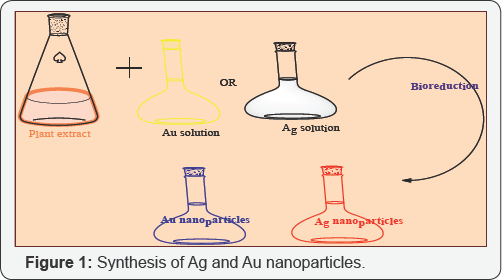Green Synthesis (Using Plant Extracts) of Ag and Au Nanoparticles-Juniper publishers
Global Journal of Nanomedicine-Juniper publishers
Introduction
The prefix 'nano' indicates one billionth or 10-9 units [1]. In other words, nanoparticles can be defined as the clusters of atoms in the size range of 1-100nm [2]. The nanoparticles show unique physical, chemical and biological properties due to their high surface-to-volume ratio [3].

The integration of green chemistry to nanotechnology is one of the most alarming and explored area for the nanoscience researcher. The towering environmental issues had attracted the researchers towards the novel green synthesis of nanoparticles in biological systems such as bacteria, fungi and plants [3]. However, exploration of the plant extracts as the medium of synthesis has heightened interest due to its simplicity, easiness and viable approach and also, the use of plant extracts for the synthesis of nanoparticles does not require elaborate processes [3,4]. Plant extracts acts as a natural reducing and stabilizing agent at ambient condition (Figure 1). Various nanoparticles such as Ag, Au, Pt and Pd have been synthesized via various green synthesis by many researchers [4,5].
Among the various nanoparticles, Ag and Au nanoparticles are especially attractive owing to their easy preparation, large specific surface area, good biocompatibility and high antimicrobial activity. Ag and Au nanoparticles play a significant role in the field of biology, medicine etc., and due to its attractive physicochemical properties [5]. Ag and Au nanoparticles find potential applications in the treatment of cancer hyperthermia, in electronics, catalysis, bio-labelling, biosensors devices for the detection of viruses and bacteria, drug delivery, tissue/ tumor imaging, photo thermal therapy etc., [4,5]. In daily life, nanoparticles of Ag and Au are widely used in shampoos, soaps, detergents, shoes, cosmetic products and toothpaste.
Discussion
Ag and Au nanoparticles have been synthesized by various researchers using plant extracts. Some of the key studies have been reported here. Synthesis of highly stable Ag nanoparticles by the extract of geranium leaves (Pelargonium graveolens) has been reported [6]. The seed extract of Jatrophacurcas was utilized for the synthesis of Ag nanoparticles [7]. Another research revealed the synthesis of Ag and Au nanoparticles using a leaf extract of Phyllanthusamarus and Black tea leaf extract, respectively [4,5]. Another study reported the synthesis of gold nanoparticles by lemon grass (Cymbopogonflexuosus) plant extract [1]. The biosynthesized Ag nanoparticles using Acalypha indica leaves extract was also reported [3]. Another study revealed the production of gold and silver nanoparticles in aqueous solution at ambient conditions using green tea (Camellia sinensis) extract as reducing and stabilizing agent [8].
Another synthesis of Au nanoparticles was reported using leaf extract of antidiabetic potent Cassia auriculata and Ag nanoparticles by aqueous leaf extract of Catharanthusroseus, respectively [9,10]. Synthesis of gold nanoparticles was reported using leaf extract of Magnolia Kobus [11]. Synthesis of silver nanoparticles using Terminaliachebula fruit extract [12]. Synthesis of silver nanoparticles was reported by Morusnigra leaf extract [13]. Synthesis of silver nanoparticles was reported from the leaf extract of Azhadirachtaindica [14]. Gold nanoparticles was synthesized using Solanuslycopersicum (Tomato) aqueous extract [15]. Another study was reported for the synthesis of silver nanoparticles using fresh tomato pomace extract [16]. The Ag nanoparticles was produced from peel extract of Tangerine [17].
Conclusion
There has been growing interest in ecofriendly green synthesis of nanoparticles. Nanoparticles such as Ag and Au finds enormous application in almost every field such as in the areas of chemistry, electronics, medicine and daily products etc. Hence, the green synthesis of nanoparticles using various plant extracts appears to be the cost effective and simple alternative for the synthesis of Ag and Au nanoparticles.
For More Articles in Global Journal of Nanomedicine
https://juniperpublishers.com/gjn/GJN.MS.ID.555589.php
Please Click on: https://juniperpublishers.com/gjn/index.php
For More Open AccessJournals In Juniper Publishers Please Click on: https://juniperpublishers.com/index.php

Comments
Post a Comment